Moon
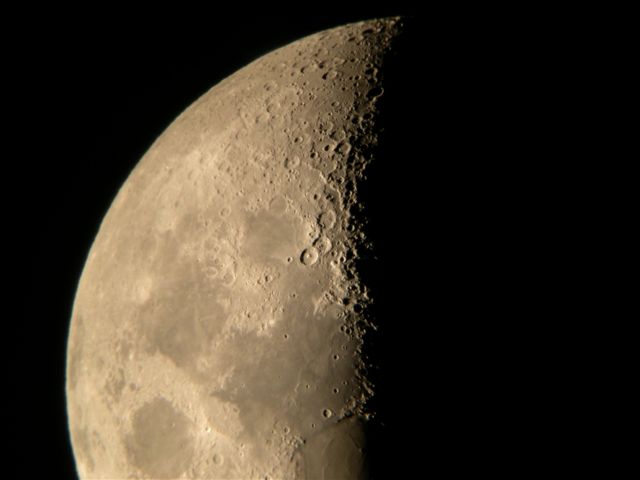
Figure 1. The Moon imaged through an 11-ichn Schmidt-Cassegrain (30 mm eyepiece) and attached Nikon 4-megapixel camera. The dark patches are called maria from the Latin mares meaning "seas." We know now that these regions are not water-filled but are basins containing dark-colored basalt – vast craters gouged out by impacting asteroids, billions of years ago, which were subsequently flooded with lava. Courtesy: Jim Wentworth, "Fire in the Sky Observatory," Brainerd, Minnesota.
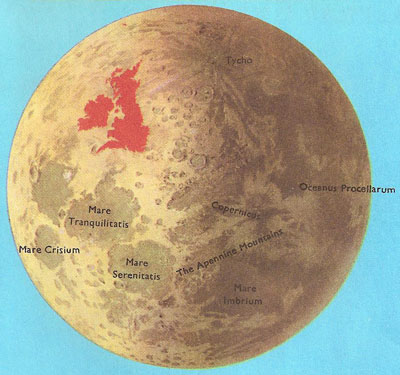
Figure 2. The size of the Moon and the British Isles compared.
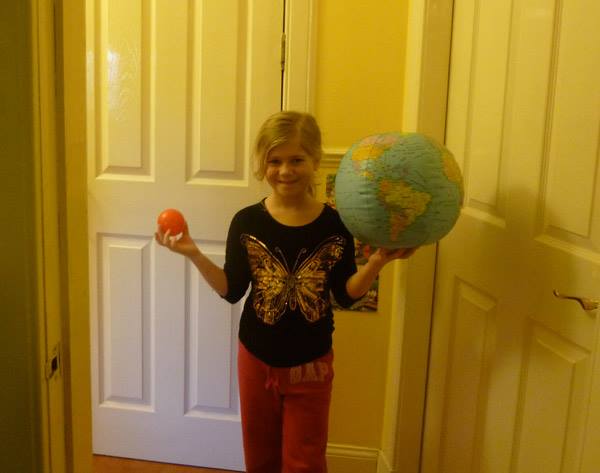
Figure 3. The Earth and the Moon shown in their correct relative sizes. They would need to be about 30 ft apart to show the separation distance to the same scale.

Figure 4. Lunar maria visible from Earth.

Figure 5. Craters at and around the Moon's north pole. Those circled in red were formed relatively recently. Those indicated by green arrows are believed, from measurements made by the Mini-SAR instrument of the Chandrayaan-1 spacecraft, to contain water-ice.
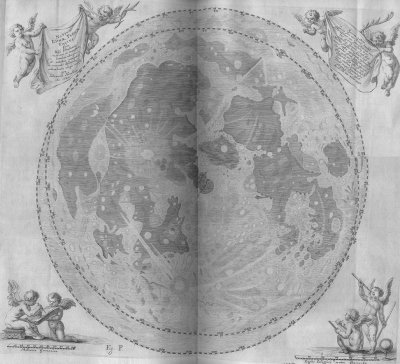
Figure 6. Map of the Moon by Hevelius.

Figure 7. Domingo Gonsales heads skyward in Cyrano de Bergerac's A Comical History of the States and Empires of the Sun and the Moon.
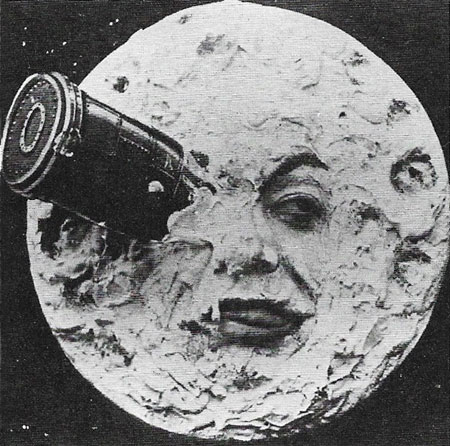
Figure 8. This frame from George Méliès' film shows the arrival of the rocket (to the dismay of the Moon), after which the space travellers go for a walk on the surface, not forgetting to put up their umbrellas to shield themselves from the strong sunlight. The film was short but popular and a favorite at scientific conferences.

Figure 9. A supermoon, photographed on May 5, 2012, from Mazatlan, Mexico.
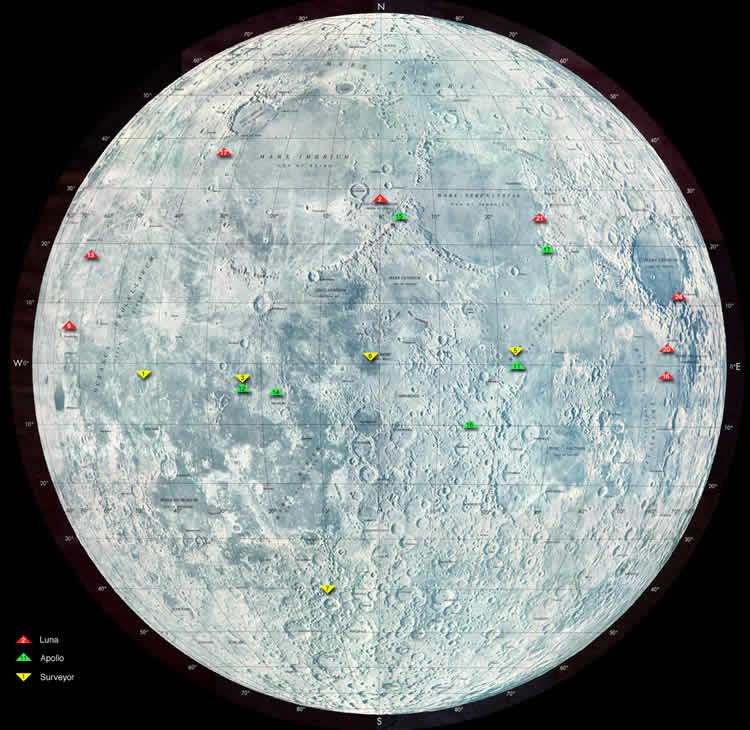
Figure 10. Landing sites of Luna, Surveyor, and Apollo missions. Image: NASA Goddard Space Flight Center
The Moon is Earth's only natural satellite and the only extraterrestrial body to have been visited by humans – 12 in all aboard six Apollo missions between July 1969 and December 1972. It has also been the target of numerous robotic probes including, most recently, Clementine (1994), Lunar Prospector (1999), SMART-1 (2003), Kaguya (2007), Chang'e 1 (2007), Chandrayaan 1 (2008), Lunar Reconnaissance Orbiter, and Lunar Crater Observation & Sensing Satellite (both 2009).
A total of 382 kg of rock samples were returned to Earth by Apollo and the Russian Luna programs; in addition, a number of lunar meteorites have been found. Most of these samples have been dated at between 4.6 and 3 billion years (the one exception is a lunar meteorite dated at 2.8 billion years), and provide information about the early history of the Solar System which is missing on Earth due to a lack of rocks more than about 3.8 billion years old.
The Moon is unusually large relative to the size of its primary (being exceeded by Charon alone in this respect). Its crust averages 68 klometers thick, is thinner on the near side, and varies from essentially zero thickness under Mare Crisium to a depth of 107 kilometers north of the crater Korolev on the lunar farside. Below the crust is a mantle and probably a small core, some 340 kilometers in radius, containing about 2% of the lunar mass.
Curiously, the Moon's center of mass is offset from its geometric center by about 2 kilometers in the direction toward Earth.
The prefix "seleno-" means to do with the Moon, as in selenocentric (with reference to the center of the Moon) and selenography (the study of the Moon's surface and description of its topography).
Size compared with Earth
The Moon's diameter is 3,474 kilometers and Earth's is 12,800 kilometers, so Earth has 3.68 times the diameter of the Moon (Figures 2 and 3). The surface area of Earth is about 13 times that of the Moon (which has roughly the surface area of Africa), and about 50 Moons could be fitted inside Earth's volume. The Moon's mass is 81 times less than Earth's.
Origin and early history
 |
| Theia impact hypothesis
|
The Moon's origin remains a matter of debate, though until recently the widely held view was that it formed over 4.5 billion years ago from debris resulting from a relatively slow, near head-on collision between Earth and a Mars-sized body, called Theia. In 2012 this theory was challenged as a result of computer simulations which showed that the impact may have an involved a much larger and faster-moving object.1 The larger impactor would have caught Earth only a glancing blow, cleaving off a portion of our planet, which subsequently gathered back together again, from a disk of hot debris, to form the Moon. In this new scenario, very little of the impactor would have contributed to the substance of the Moon – a situation that ties in more neatly with the observation that certain isotope ratios (notably of oxygen and titanium) in lunar surface material are almost identical to those found in Earth rocks.
The outer layers of the Moon, initially molten and comprising a global "magma ocean", cooled to form the 4.5-billion-year-old rocks now found in the lunar highlands. These ancient igneous rocks known as anorthosites are rich in the silicate mineral plagioclase and impart to the lunar highlands their characteristic light color. A period of intense bombardment followed which caused extensive cratering and fragmentation of the crust. About 4 billion years ago, the Moon suffered a number of major impacts which excavated the basins referred to as maria. Subsequent volcanic activity, between about 4 and 2.5 billion years ago, flooded these basins with molten lava which then cooled and solidified to form dark basalt. Since that time, the Moon has changed little except for the occasional impact of a meteorite or comet.
Maria
Maria are large dark regions on the surface of the Moon, once thought to be seas, now known to be lava-flooded basins (Figure 4). The term 'mare soil' refers to the sediment on the surface of the lunar maria; it consists of fragments of basalt rocks, broken mineral grains, and glass produced by impact.
Geological activity
However, the Moon is not completely inactive. Seismometers left on the lunar surface by the Apollo astronauts have recorded small seismic events, known as "moonquakes", occurring at depths of several hundred kilometers, which probably result from tidal stresses induced by Earth's gravitational pull. In addition, there have been many reports over the years of unusual color changes and cloud-like obscurations associated with certain craters, including Aristarchus and Alphonsus, and referred to as transient lunar phenomena. Most unusually, Ken Mattingley, the Command Module pilot on Apollo 16, reported seeing flashes of light on the dark side of the Moon on two consecutive orbits of his craft.
Mass concentrations, or mascons, associated with the circular maria such Mare Imbrium, and thought to be caused by layers of denser, basaltic lava, were discovered as a result of their gravitational effect on the orbital motions of Lunar Orbiter probes in the 1960s. Local magnetic areas have also been detected around some craters, although the Moon has no global magnetic field.
 |
| Topography (top) and surface gravity (bottom) for
Mare Serenitatis. The gravity shows a plateau and thus a substantial
near-surface contribution to the mascon. Also apparent is the smaller
mascon Mare Vaporum in the lower left and center part of the figure.
Data from Lunar Prospector.
|
Air and water
For a long time, people thought that the dark patches we can see on the Moon with our unaided eyes might be bodies of water. In fact we still call these features maria from the Latin word mares meaning "seas." The Greek historian Plutarch was among those in the ancient world who expressed this view in his writings.
Much later, in his short but influential treatise Siderius Nunctius (Starry Messenger), Galileo wrote: " ... [the] brighter part [of the Moon] most fitly represents its land surface, but its darker part the watery surface ..." Later, he came to doubt this interpretation, but others, including John Wilkins, Johannes Hevelius, Johann Schröter, and William Herschel kept the idea of a maritime Moon alive for the next two centuries.
Not surprisingly, the belief that there were great bodies of water on the
Moon was accompanied by the belief that there might also be life there, including intelligent
life.
But the notion of lunar water fell from favor as it became clear that the
Moon lacks any kind of substantial atmosphere. Physics is very clear on
the fact that liquid water can't survive on a surface where the atmospheric
pressure is extremely low or zero.
Ice on the Moon
But what is true of liquid water isn't necessarily true of solid water – ordinary ice. The problem for ice on the Moon is that most of the Moon's surface experiences wide swings in temperature, from very cold to very hot depending on whether the Sun is shining or not. The average surface temperature during the day is 107°C (with a maximum of 123°C) – well above the boiling point of water; at night it dips to an average, over the whole Moon, of –153°C (and a minimum of –233°C). During a complete lunar day, the Sun's rays illuminate most of the Moon's surface making it impossible for any ice on or near the surface to survive. However, there are many craters at or near the north and south lunar poles whose depths lie in permanent shadow. Any ice that had been deposited in such craters, long ago, could in theory still be there today.
To test this possibility, several recent lunar orbiting probes have been equipped with instruments that can detect, in various ways, the presence of water-ice on the Moon. The first data to suggest that there is ice at the Moon's poles came from the Clementine probe, in 1994. Confirmation came in Mar 1998 from observations made by Lunar Prospector1 which led to an initial conservative estimate of 300 million tons of ice. The instrument aboard Lunar Prospector used for this determination could detect the presence of water-ice (or, more precisely, hydrogen) to a depth of 0.5 meter. Since lunar soil has been turned over by meteorite impacts during the past couple of billion years to a depth of about 2 meters, water could theoretically be present to this depth. However, if this water exists as crystals mixed in with the lunar regolith, larger amounts of pure water ice deposits could potentially exist at much greater depths.
NASA's mini-SAR instrument carried on India's Chandrayaan lunar orbiting spacecraft in 2009 provided further information on the lunar ice. Mini-SAR, a lightweight, synthetic aperture radar, found ice in more than 40 small craters. These craters range in size from 2 to 15 kilometers (1 to 9 miles) in diameter. Although the total amount of ice depends on its thickness in each crater, it is estimated there could be at least 600 million metric tons of water ice.
The lunar ice is thought to have come from comets which collided with the Moon in the remote past. Although most of the water deposited on the lunar surface in this way would have been vaporized long ago by the daytime heat of the Sun, in small, permanently shaded regions at the poles it has evidently survived. Its presence is further evidence that water, frozen or otherwise, is a common commodity on many worlds, and this, in turn, raises the prospects for extraterrestrial life. The availability of water on the Moon is also a major boost to any plans for establishing a self-sustaining lunar colony.
Reference
1. Feldman, W. C., Maurice, S., Binder, A. B., Barraclough, B. L., Elphic, R. C., and Lawrence, D. J. "Fluxes of Fast and Epithermal Neutrons from Lunar Prospector: Evidence for Water Ice at the Lunar Poles," Science, 281, 1496 (1998).
Speculation about lunar life
Among ancient philosophers to speculate about possible lunar inhabitants were Anaxagoras, Xenophanes, Pythagoras and his followers, Plutarch, and (in fiction) Lucian. In the late middle ages, Nicholas of Cusa favored life on the Moon. However, speculation became more intense following the Copernican revolution and Galileo's first lunar studies with the aid of a telescope (1608). In his Discovery of a New World in the Moone (1638), John Wilkins summarized what were then widely held beliefs:
That those spots and brighter parts which by our sight might be distinguished in the Moon, do show the difference between the Sea and Land of that other World... The spots represent the Sea, and the brighter parts Land... That there are high mountains, deep valleys, and spacious plains in the body of the Moon... That there is an atmosphere, or an orb of gross vaporous air, immediately encompassing the body of the Moon... That it is probable there may be inhabitants in this other World, but of what kind they are is uncertain...
Even at this early stage, however, there was sharp disagreement over how to interpret what the telescope showed. The two great lunar map-makers of the 17th century, Johannes Hevelius and Giovanni Riccioli, stood at opposite poles of the debate. Whereas Hevelius populated his chart with seas and "selenites" (as he called his lunar inhabitants), Riccioli's Moon was dry and dead. The battle over lunar life continued throughout the 18th century, Johann Bode and William Herschel being notable among the pro-selenites.
By the turn of the 19th century, persuasive evidence was accumulating that the Moon lacked both sufficient air and water to support substantial life. Yet still the selenites had their champions, including the extremists Schröter and Gruithuisen, and the moderates Gauss, von Littrow, and Olbers. Improved lunar maps in the 1830s, by Wilhelm Lohrmann and by Beer and Mädler, helped persuade most astronomers that the Moon was unlikely to be inhabited. Even so, this did not prevent Richard Locke from creating a worldwide sensation in 1835 with his great "Moon Hoax".
By the end of the 19th century, lunar life had passed more or less from the realm of science into that of science fiction. Jules Verne posed the question in Around the Moon (1870) and teased with his reply, George Griffith's adventurers in Stories of Other Worlds (1900) find the ruins of a civilization and its bestial offspring, while, as late as 1901, in The First Men in the Moon, H. G. Wells was able to exploit lingering public credulity with his tale of a hollow Moon, richly varied selenites, and massively cerebral Grand Lunar.
And yet the romance did not quite end with these gaslight fantasies. In the 1920s, William H. Pickering, a staunch advocate of Martian vegetation argued that certain dark areas on the Moon which changed shape were due to spreading plants,1 while almost half a century later the remote possibility of microbial lunar life was still on the minds of NASA scientists when they quarantined the first Apollo astronauts and their rock samples (see back-contamination) – a well-advised (but, in the event, ill-performed) precaution in view of the bacterial survivors found on the returned camera of Surveyor 3. Arthur C. Clarke suggested remains of another kind on the Moon in his short story "The Sentinel"2 which blossomed into 2001: A Space Odyssey.
In reality, it seems, the Moon has always been dead. However, the prospects for future intelligent (human) life on our nearest neighbor have been greatly improved by the discovery of billions of tons of ice in some deep lunar craters.
References
1. Pickering, W. H. "Eratosthenes," 1 to 6, Popular Astronomy,
nos. 269, 287, 312, and 317 (1919–1925).
2. Clarke, Arthur C. "The Sentinel." In Expedition to Earth. New
York: Harcourt, Brace and World (1970).
Fictional voyages
Almost 1500 years separated Lucian's first imaginary lunar excursions from those of Ariosto (1532), Kepler (1634), bishops Godwin (1638) and Wilkins (1640), and de Bergerac (1656). All these tales involved the discovery of intelligent lunar beings and assumed that air extends from Earth to the Moon (Figure 7).
Following the invention of the balloon, in 1783, it became clear that humans could not survive unprotected at high altitude and speculation focused for a while on terrestrial, atmospheric travel. By the second half of the 19th century, however, space sojourns were once again on the fictional agenda, with Jules Verne, George Griffith, H. G. Wells, and others offering varied glimpses of a world that would not be reached in reality until the 1960s.1,2
A century and a half ago Verne described a circumlunar voyage; H. G. Wells imagined a fantastic world people by insect-like beings. In 1902 came the first famous Moon voyage film, produced by George Méliès (Figure 8).
References
1. Miller, Ron. "Astronauts by Gaslight," Ad Astra, 42 (September–October
1994).
2. Nicolson, Marjorie Hope. Voyages to the Moon. New York: Macmillan
(1948).
Earth-Moon interactions
The gravitational forces between Earth and the Moon cause some interesting effects, the most obvious of which is the tides. The Moon's gravitational attraction is stronger on the side of Earth nearest to the Moon. Since Earth and its oceans are not perfectly rigid, they are stretched along the line toward the Moon. From our perspective, we see two small bulges, one in the direction of the Moon and one directly opposite. The effect is much stronger in the oceans than in the solid crust so the water bulges are higher. Also, because Earth rotates much faster than the Moon moves in its orbit, the bulges move around Earth about once a day producing two high tides per day.
However, as Earth is not completely fluid, Earth's rotation carries our planet's bulges slightly ahead of the point directly beneath the Moon. This means that the force between Earth and the Moon isn't exactly along the line between their centers; the result is a torque on Earth and an accelerating force of the Moon. This causes a net transfer of rotational energy from Earth to the Moon, slowing down Earth's rotation by about 1.5 milliseconds per century and raising the Moon into a higher orbit by about 3.8 cm/y.
The asymmetric nature of this gravitational interaction is also responsible for the fact that the Moon rotates synchronously, i.e. it is locked in phase with its orbit so that the same side is always facing toward us. Just as Earth's rotation is now being slowed by the Moon's influence so in the distant past the Moon's rotation was slowed by the action of Earth, but in that case the effect was much stronger. When the Moon's rotation rate was slowed to match its orbital period (such that the bulge always faced toward Earth) there was no longer an off-center torque on the Moon and a stable situation was achieved. The same thing has happened to most of the other satellites in the Solar System. Eventually, Earth's rotation will be slowed to match the Moon's period, too, as is the case with Pluto and Charon.
The Moon appears to wobble a bit (due to its slightly non-circular orbit) so that a few degrees of the far side can be seen from time to time, but the majority of the far side was completely unknown until Luna 3 photographed it in 1959.
Earthshine
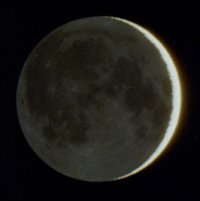 |
Earthshine is light reflected from Earth and its atmosphere onto the dark part of the Moon when it is not full. Earthshine explains why the full disk of the Moon remains dimly visible even when only part of it is illuminated by sunlight.
| mean distance from Earth center | 384,400 km (238,906 mi) |
| diameter | 3,476 km (2,160 miles) |
| mass (Earth=1) | 0.0122 |
| mean density | 3.34 g/cm3 |
| surface gravity (Earth=1) | 0.165 |
| escape velocity | 2.38 km/s (5,325 mph) |
| orbital period | 27.3 days |
| orbital eccentricity | 0.055 |
| orbital inclination | 5.1° |
| axial period | 27.3 days (gravitational lock) |
| max. surface temperature | 117 °C (243 °F) |
| min. surface temperature | -163 °C (-261 °F) |
| albedo | 0.07 |
| Some notable features on the Moon | |
|---|---|
| Feature | Description |
| Aitken Basin | An impact basin in the south polar region. With a diameter of about 2,500 kilometers, a maximum depth of over 12 kilometers, and an average depth of about 10 kilometers, it is the biggest, deepest impact basin in the solar system |
| Apennines | A mountain range that rises to 4,572 meters at the southeastern edge of Mare Imbrium. The highest escarpment on the Moon, it is higher above the adjacent flatlands than the Himalayan front is above the plains of India and Nepal. The landing site of Apollo 15 was chosen to allow the astronauts to drive from the Lunar Module to the base of the Apennines during two excursions |
| Bailly | The largest crater on the nearside of the Moon with a diameter of 295 km and maximum depth of 3.96 kilometers. A highly eroded structure, it is named after the French astronomer Jean Bailly |
| Copernicus | A 93-km-wide crater that is one of the most prominent features on the lunar nearside. Made less than 1 billion years ago, and thus one of the Moon’s youngest major markings, it has a system of bright rays seen most clearly at full Moon |
| Imbrium Basin | The largest and youngest of the giant impact basins on the nearside of the Moon. The asteroid collision that formed it, about 3.9 billion years ago, went close to breaking the Moon apart; in the event, it threw ejecta over much of the lunar surface and created deep fissures. Through these cracks, lava poured out, filling much of the basin and leaving the 1,300-kilometer-wide dark feature known as Mare Imbrium |
| Orientale Basin | The youngest and best preserved impact basin on the Moon, visible from Earth only at the extreme western limb as a libration feature. Formed some 3.8 to 3.9 billion years ago, it is shows three concentric rings of mountains. Strong radial lineations made by the scouring flow of ejecta are also evident |
| Tycho | A spectacular, 85-km-wide crater associated with the brightest and most extensive ray system on the Moon. In some cases, the rays extend for over 1,500 kilometers; their prominence suggests that Tycho was formed relatively recently, perhaps within the past 3 billion years |
Harvest moon and hunter's moon
A harvest moon is the full moon that appears closest in time to the autumnal equinox, in late September or early October in the Northern Hemisphere. For several nights the full moon rises at about the same time (around sunset), and may be bright enough for harvesting to continue into the night. In the Southern Hemisphere this occurs around the spring equinox.
A hunter's moon is the next full moon after the harvest moon; it usually falls in October. Thought of as providing more light for the night hunter, it rises, as does the harvest moon, around the time of sunset for several successive nights in mid- or high-northern latitudes.
Blue moons and supermoons
Blue moon
A blue moon is the second full moon in a month that has two full moons (see lunar phases), or a blue moon is the third full moon in a season of the year that has four full moons (usually each season has only three full moons.)
Supermoons
A supermoon, also known as a perigee full moon, is the Moon when seen from Earth at the biggest and brightest that it can possibly appear. During a supermoon occurrence, the Moon appears up to 14% bigger and 30% brighter than when it is furthest from Earth (Figure 7).
Supermoons happen when the Moon is both full (i.e. on the opposite side of the Earth from the Sun) and also at a minimum distance from Earth in its elliptical orbit – when it is just 356,400 kilometers (221,457 miles) away, compared to its mean distance of 384,000 kilometers (238,606 miles).
The term 'supermoon' derives from modern astrology and is not used within the astronomical community, which uses the terms perigee full moon or perigee-syzygy moon.
Reference
1. Reufer, A., Meier, M. M. M., Benz, W., and Wieler, R. "A hit-and-run Giant Impact scenario." Icarus, in press. Cite as arXiv:1207.5224v1. (July 2012)
Unmanned spacecraft


